Obelisk
Obelisk of Psametik II from Heliopolis
reerected by Augustus in northern Campus Martius
Purpose of the obelisk? This obelisk, erected by Augustus in the northern Campus Martius in 10-9 BCE, had been quarried nearly 6 centuries before at Aswan, Egypt. The obelisk had been erected by Psammetichus II (Psametik II), reigned 594-589 BCE, as one of a pair of obelisks, dedicated to the sun god at the sanctuary to Re in Heliopolis. It was removed from Heliopolis by Augustus, shipped across the Mediteranean, and reerected in the northern Campus Martius 10-9 BCE as a single obelisk, also dedicated to the sun. This was the first of several obelisks removed from Egypt and reerected in Rome. It has been seen both as a symbol of the Roman conquest of Egypt and as a symbol of the inclusion of Egypt as part of the Roman empire.
As reerected by Augustus, the obelisk was mounted on a new rose granite base, quarried from the same source as the original obelisk. The base was then inscribed on 2 sides (see photos and text next page) and a metal globe with spire attached to the obelisk's pinnacle. A travertine pavement with a single bronze guideline, with cross markers, known as the meridian, was installed, running approximately north of the obelisk. These cross lines marked the 360 degrees of the solar year. The obelisk then served as the pointer or gnomom of a sundial that tracked the length of the obelisk's shadow each day at noon. This made it possibe to confirm the accuracy Augustus' correction to the 365 1/4 day calendar. The obelisk also served as a fulcrum, helping to tie together the three major Augustan monuments in the area: the obelisk, Ara Pacis, and, most prominently, the Mausolum of Augustus.
For years, many scholars accepted the proposal that the obelisk was not only the pointer for a sundial tracking the changing length of the obelisk’s shadow each day along a meridian, but was in addition the gnomon for a complex horologium-solarium, with bronze rods projecting across a vast travertine pavement. For years it was so represented in most diagrams, paintings, and models. Partly because no-one has been able to find evidence to support this idea, it has gradually been discounted by scholars.
TO ZOOM IN ON THE LARGE IMAGES, USE THE BUTTONS AT TOP-LEFT.
Tips for using this website
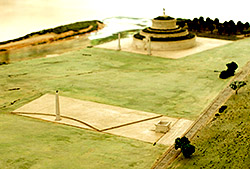
Model of Northern Campus Martius during the Augustan period. Looking northwest past the obelisk and Ara Pacis to the Mausoleum of Augustus. On display in the Museo dell'Ara Pacis. Model gift of Rotary Club Roma Sud, made by the Istituto Statale d'Arte Roma 2.
photo May 2010
|
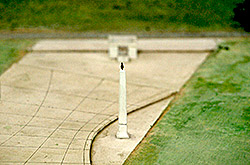
Model of Northern Campus Martius during the Augustan period. Looking past the obelisk to the ceremonial entrance (west) front of the Ara Pacis. On display in the Museo dell'Ara Pacis. Model gift of Rotary Club Roma Sud, made by the Istituto Statale d'Arte Roma 2.
photo July 2008
|
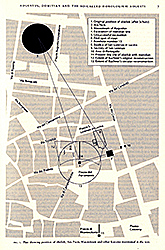
"Fig. 1. Plan showing position of obelisk, Ara Pacis, Mausoleum and other features mentioned in the text".
The author points out that nos. 12 and 13, once proposed as a vast sundial related to the Ara Pacis, are not supported by any evidence and that only no. 4, a single meridian, ever existed.
Scanned from Peter Heslin, "Augustus, Domitian and the So-called Horologium Augusti", Journal of Roman Studies, vol. 97 (20027), pp. 1-20. Drawing by the author. Reproduced with appreciation. |
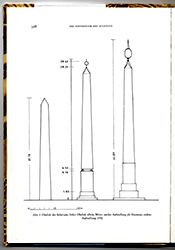
Comparison of the Obelisk of Psametik II from Heliopolis with its reerection by Augustus in the northern Campus Martius in 10-9 BCE (with added base and globe) and with its reerection by Pope Pius VI in 1792 (with an additional added base and new globe) in the Piazza Montecitorio where it still stands.
"Pl.1 Obelisk of the Sundial; left: Obelisk alone, middle: ancient set-up as a gnomon; right: set-up 1792".
Scanned from Buchner, "Solarium Augusti und Ara Pacis", 1976 (1982), p.328, fig.1. Reproduced with appreciation.
|
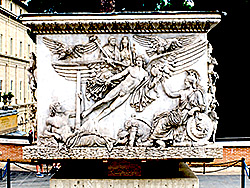
Front of the marble base of the now lost Column of Antoninus Pius (reigned 138-161 CE), thus dating from about 161 CE. On display at the Vatican Museum. The relief on this side of the base shows the apotheosis of the deified Emperor Antoninus Pius and his wife, Faustina, above a winged figure. At the right Roma leans on a shield with an image of the legendary founders of Rome, Romulus and Remus, suckled by the she wolf. Although not closely followed, this is a key image of Roma available for the hypothetical reconstruction of Roma on the Ara Pacis Roma relief.
photo May 2010
|
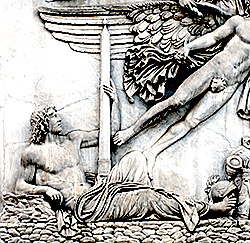
Detail of the marble relief in photo at left. The reclining male figure holds an obelisk, which seems closest in appearance to the Obelisk of Psametik II, which Augustus had reerected on the Campus Martius near the Ara Pacis. The figure holding the obelisk has long been considered a personification of the Campus Martius.
photo May 2010
|
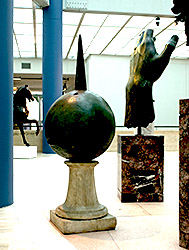
The spacious, sunlit Hall of Marcus Aurelius of the Capitoline Museums, Rome; with major bronze sculptures.
photo May 2010
|
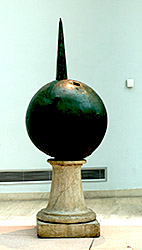
Bronze globe with spire, thought to be the globe added to the pinnacle of either the Vatican obelisk or to the obelisk of Psametik II, when erected on the Campus Martius by Augustus, 10-9 BCE.
photo May 2010 |
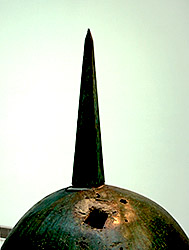
Upper portion of bronze globe in photo at left, showing the 4-sided, tapered spire.
photo May 2010
|
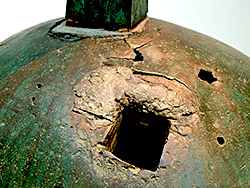
Detail of bronze globe in photos above, showing overlapping bronze sheets.
photo May 2010
|
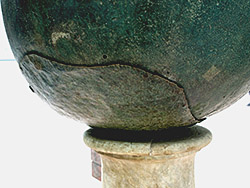
Base of bronze globe in photo above.
photo May 2010
|
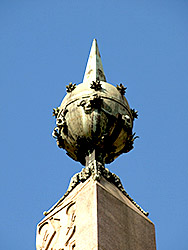
New bronze globe installed by Pope Pius VI on pinnacle of obelisk of Psametik II and Augustus, when reerected on the Piazza Montecitorio in 1792.
photo May 2010 |











